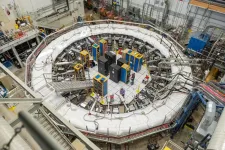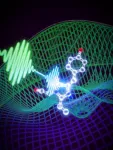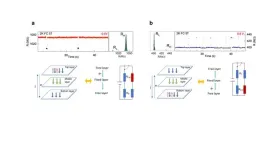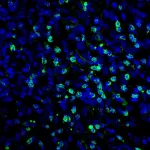(Press-News.org) Batavia, Ill., Aug. 10, 2023 – Physicists now have a brand-new measurement of a property of the muon called the anomalous magnetic moment that improves the precision of their previous result by a factor of 2.
An international collaboration of scientists working on the Muon g-2 experiment at the U.S. Department of Energy’s Fermi National Accelerator Laboratory announced the much-anticipated updated measurement on Aug. 10. This new value bolsters the first result they announced in April 2021 and sets up a showdown between theory and experiment over 20 years in the making.
“We’re really probing new territory. We’re determining the muon magnetic moment at a better precision than it has ever been seen before,” said Brendan Casey, a senior scientist at Fermilab who has worked on the Muon g-2 experiment since 2008.
Physicists describe how the universe works at its most fundamental level with a theory known as the Standard Model. By making predictions based on the Standard Model and comparing them to experimental results, physicists can discern whether the theory is complete — or if there is physics beyond the Standard Model.
Muons are fundamental particles that are similar to electrons but about 200 times as massive. Like electrons, muons have a tiny internal magnet that, in the presence of a magnetic field, precesses or wobbles like the axis of a spinning top. The precession speed in a given magnetic field depends on the muon magnetic moment, typically represented by the letter g; at the simplest level, theory predicts that g should equal 2.
The difference of g from 2 — or g minus 2 — can be attributed to the muon’s interactions with particles in a quantum foam that surrounds it. These particles blink in and out of existence and, like subatomic “dance partners,” grab the muon’s “hand” and change the way the muon interacts with the magnetic field. The Standard Model incorporates all known “dance partner” particles and predicts how the quantum foam changes g. But there might be more. Physicists are excited about the possible existence of as-yet-undiscovered particles that contribute to the value of g-2 — and would open the window to exploring new physics.
The new experimental result, based on the first three years of data, announced by the Muon g-2 collaboration is:
g-2 = 0.00233184110 +/- 0.00000000043 (stat.) +/- 0.00000000019 (syst.)
The measurement of g-2 corresponds to a precision of 0.20 parts per million. The Muon g-2 collaboration describes the result in a paper that they submitted today to Physical Review Letters.
With this measurement, the collaboration has already reached their goal of decreasing one particular type of uncertainty: uncertainty caused by experimental imperfections, known as systematic uncertainties.
“This measurement is an incredible experimental achievement,” said Peter Winter, co-spokesperson for the Muon g-2 collaboration. “Getting the systematic uncertainty down to this level is a big deal and is something we didn’t expect to achieve so soon.”
While the total systematic uncertainty has already surpassed the design goal, the larger aspect of uncertainty — statistical uncertainty — is driven by the amount of data analyzed. The result announced today adds an additional two years of data to their first result. The Fermilab experiment will reach its ultimate statistical uncertainty once scientists incorporate all six years of data in their analysis, which the collaboration aims to complete in the next couple of years.
To make the measurement, the Muon g-2 collaboration repeatedly sent a beam of muons into a 50-foot-diameter superconducting magnetic storage ring, where they circulated about 1,000 times at nearly the speed of light. Detectors lining the ring allowed scientists to determine how rapidly the muons were precessing. Physicists must also precisely measure the strength of the magnetic field to then determine the value of g-2.
The Fermilab experiment reused a storage ring originally built for the predecessor Muon g-2 experiment at DOE’s Brookhaven National Laboratory that concluded in 2001. In 2013, the collaboration transported the storage ring 3,200 miles from Long Island, New York, to Batavia, Illinois. Over the next four years, the collaboration assembled the experiment with improved techniques, instrumentation and simulations. The main goal of the Fermilab experiment is to reduce the uncertainty of g-2 by a factor of four compared to the Brookhaven result.
“Our new measurement is very exciting because it takes us well beyond Brookhaven’s sensitivity,” said Graziano Venanzoni, professor at the University of Liverpool affiliated with the Italian National Institute for Nuclear Physics, Pisa, and co-spokesperson of the Muon g-2 experiment at Fermilab.
In addition to the larger data set, this latest g-2 measurement is enhanced by updates to the Fermilab experiment itself. “We improved a lot of things between our first year of taking data and our second and third year,” said Casey, who recently finished his term as co-spokesperson with Venanzoni. “We were constantly making the experiment better.”
The experiment was “really firing on all cylinders” for the final three years of data-taking, which came to an end on July 9, 2023. That’s when the collaboration shut off the muon beam, concluding the experiment after six years of data collection. They reached the goal of collecting a data set that is more than 21 times the size of Brookhaven’s data set.
Physicists can calculate the effects of the known Standard Model “dance partners” on muon g-2 to incredible precision. The calculations consider the electromagnetic, weak nuclear and strong nuclear forces, including photons, electrons, quarks, gluons, neutrinos, W and Z bosons, and the Higgs boson. If the Standard Model is correct, this ultra-precise prediction should match the experimental measurement.
Calculating the Standard Model prediction for muon g-2 is very challenging. In 2020, the Muon g-2 Theory Initiative announced the best Standard Model prediction for muon g-2 available at that time. But a new experimental measurement of the data that feeds into the prediction and a new calculation based on a different theoretical approach — lattice gauge theory — are in tension with the 2020 calculation. Scientists of the Muon g-2 Theory Initiative aim to have a new, improved prediction available in the next couple of years that considers both theoretical approaches.
The Muon g-2 collaboration comprises close to 200 scientists from 34 institutions in seven countries and includes nearly 40 students so far who have received their doctorates based on their work on the experiment. Collaborators will now spend the next couple of years analyzing the final three years of data. “We expect another factor of two in precision when we finish,” said Venanzoni.
The collaboration anticipates releasing their final, most precise measurement of the muon magnetic moment in 2025 — setting up the ultimate showdown between Standard Model theory and experiment. Until then, physicists have a new and improved measurement of muon g-2 that is a significant step toward its final physics goal.
The Muon g-2 experiment is supported by the Department of Energy (US); National Science Foundation (US); Istituto Nazionale di Fisica Nucleare (Italy); Science and Technology Facilities Council (UK); Royal Society (UK); European Union’s Horizon 2020; National Natural Science Foundation of China; MSIP, NRF and IBS-R017-D1 (Republic of Korea); and German Research Foundation (DFG).
Fermilab is America’s premier national laboratory for particle physics research. A U.S. Department of Energy Office of Science laboratory, Fermilab is located near Chicago, Illinois, and operated under contract by the Fermi Research Alliance LLC. Visit Fermilab’s website at https://www.fnal.gov and follow us on Twitter @Fermilab.
The DOE Office of Science is the single largest supporter of basic research in the physical sciences in the United States and is working to address some of the most pressing challenges of our time. For more information, visit https://science.energy.gov.
END
Muon g-2 doubles down with latest measurement, explores uncharted territory in search of new physics
Scientists working on Fermilab’s Muon g-2 experiment released the world’s most precise measurement yet of the magnetic moment of the muon, bringing particle physics closer to the ultimate showdown between theory and experiment that may uncover new par
2023-08-10
ELSE PRESS RELEASES FROM THIS DATE:
Making molecules dance to our tune reveals what drives their first movements
2023-08-10
Bringing ultrafast physics to structural biology has revealed the dance of molecular ‘coherence’ in unprecedented clarity.
How molecules change when they react to stimuli such as light is fundamental in biology, for example during photosynthesis. Scientists have been working to unravel the workings of these changes in several fields, and by combining two of these, researchers have paved the way for a new era in understanding the reactions of protein molecules fundamental for life.
The large international research team, led by Professor ...
Gut microbiome can increase risk, severity of HIV, EBV disease
2023-08-10
CHAPEL HILL, N.C. – Over the past decade, the gut microbiome has gained significant interest by scientists and non-scientists alike. Recent research has shown that the bacteria and other microbes in our gut play a supporting role in immunity, metabolism, digestion, and the fight against "bad bacteria" that try to invade our bodies.
However, new research published in Nature Biotechnology by Angela Wahl, PhD, Balfour Sartor, MD, J. Victor Garcia, PhD, and UNC School of Medicine colleagues others has revealed that the microbiome may not as always be protective against human pathogens.
Using a first-of-its-kind ...
YALE EMBARGOED NEWS: Yale scientists reveal two paths to autism in the developing brain
2023-08-10
New Haven, Conn. — Two distinct neurodevelopmental abnormalities that arise just weeks after the start of brain development have been associated with the emergence of autism spectrum disorder, according to a new Yale-led study in which researchers developed brain organoids from the stem cells of boys diagnosed with the disorder.
And, researchers say, the specific abnormalities seem to be dictated by the size of the child’s brain, a finding that could help doctors and researchers to diagnosis and treat autism in the future.
The findings were ...
Before reaching the skies, the Himalayas had a leg up, new study shows
2023-08-10
Mountain ranges play a key role in global climate, altering weather and shaping the flora and fauna that inhabit their slopes and the valleys below. As warm air rises windward grades and cools, moisture condenses into rain and snow. On the leeward side, it’s quite the opposite. Deserts prevail, a phenomenon known as rain shadow. Thus, the way mountain ranges form is a matter of intense interest among those who study and model climates of the past.
That debate will soon grow more heated with a new paper in the journal Nature Geoscience. A team of researchers ...
Scientists harness the power of AI to shed light on different types of Parkinson’s disease
2023-08-10
Francis Crick Institute press release
Under strict embargo: 16:00hrs BST 10 August 2023
Peer reviewed
Observational study
Cells
Researchers at the Francis Crick Institute and UCL Queen Square Institute of Neurology, working with technology company Faculty AI, have shown that machine learning can accurately predict subtypes of Parkinson’s disease using images of patient-derived stem cells.
Their work, published today in Nature Machine Intelligence, has shown that computer models can accurately classify four subtypes of Parkinson’s disease, with one reaching an accuracy of 95%. This could pave the way for personalised medicine and targeted drug discovery.
Parkinson’s ...
Researchers discover a potential application of unwanted electronic noise in semiconductors
2023-08-10
Random Telegraph Noise (RTN), a type of unwanted electronic noise, has long been a nuisance in electronic systems, causing fluctuations and errors in signal processing. However, a team of researchers from the Center for Integrated Nanostructure Physics within the Institute for Basic Science (IBS), South Korea has made an intriguing breakthrough that can potentially harness these fluctuations in semiconductors. Led by Professor LEE Young Hee, the team reported that magnetic fluctuations and their gigantic RTN signals can be generated in a vdW-layered semiconductor by introducing vanadium in ...
AI-driven muscle mass assessment could improve care for head and neck cancer patients
2023-08-10
Boston – Researchers from Dana-Farber Cancer Institute have found a way to use artificial intelligence (AI) to diagnose muscle wasting, called sarcopenia, in patients with head and neck cancer. AI provides a fast, automated, and accurate assessment that is too time-consuming and error-prone to be made by humans. The tool, published in JAMA Network Open, could be used by doctors to improve treatment and supportive care for patients.
“Sarcopenia is an indicator that the patient is not doing well. A real-time tool that tells us when a patient is losing muscle mass would trigger us to intervene and do something supportive ...
Alcohol consumption among adults with a cancer diagnosis
2023-08-10
About The Study: The findings of this study of 15,000 adults suggest that alcohol consumption and risky drinking behaviors were common among cancer survivors, even among individuals receiving treatment. Given the adverse treatment and oncologic outcomes associated with alcohol consumption, additional research and implementation studies are critical in addressing this emerging concern among cancer survivors.
Authors: Yin Cao, Sc.D., M.P.H., of the Washington University in St. Louis School of Medicine, is the corresponding author.
To ...
Five-year trajectories of prescription opioid use
2023-08-10
About The Study: The results of this study of 3.4 million adults suggest that most individuals commencing treatment with prescription opioids had relatively low and time-limited exposure to opioids over a 5-year period. The small proportion of individuals with sustained or increasing use was older with more comorbidities and use of psychotropic and other analgesic drugs, likely reflecting a higher prevalence of pain and treatment needs in these individuals.
Authors: Natasa Gisev, ...
A medication used for heart conditions improves the efficacy of current treatments for melanoma in mouse models
2023-08-10
The study, carried out by scientists from Navarrabiomed, the Institute of Neurosciences CSIC-UMH, and IRB Barcelona, has been published in Nature Metabolism.
In 2022, 7,500 new cases of melanoma—the most aggressive type of skin cancer—were diagnosed in Spain.
A collaborative study undertaken by the Navarrabiomed Biomedical Research Center (Pamplona, Navarre), the Institute of Neurosciences CSIC-UMH (Sant Joan d’Alacant, Valencian Community) and IRB Barcelona (Barcelona, Catalonia) shows that the administration of ranolazine, a drug currently used to treat heart conditions, improves the ...
LAST 30 PRESS RELEASES:
Numbers in our sights affect how we perceive space
SIMJ announces global collaborative book project in commemoration of its 75th anniversary
Air pollution exposure and birth weight
Obstructive sleep apnea risk and mental health conditions among older adults
How talking slows eye movements behind the wheel
The Ceramic Society of Japan’s Oxoate Ceramics Research Association launches new international book project
Heart-brain connection: international study reveals the role of the vagus nerve in keeping the heart young
Researchers identify Rb1 as a predictive biomarker for a new therapeutic strategy in some breast cancers
Survey reveals ethical gaps slowing AI adoption in pediatric surgery
Stimulant ADHD medications work differently than thought
AI overestimates how smart people are, according to HSE economists
HSE researchers create genome-wide map of quadruplexes
Scientists boost cell "powerhouses" to burn more calories
Automatic label checking: The missing step in making reliable medical AI
Low daily alcohol intake linked to 50% heightened mouth cancer risk in India
American Meteorological Society announces Rick Spinrad as 2026 President-Elect
Biomass-based carbon capture spotlighted in newly released global climate webinar recording
Illuminating invisible nano pollutants: advanced bioimaging tracks the full journey of emerging nanoscale contaminants in living systems
How does age affect recovery from spinal cord injury?
Novel AI tool offers prognosis for patients with head and neck cancer
Fathers’ microplastic exposure tied to their children’s metabolic problems
Research validates laboratory model for studying high-grade serous ovarian cancer
SIR 2026 delivers transformative breakthroughs in minimally invasive medicine to improve patient care
Stem Cell Reports most downloaded papers of 2025 highlight the breadth and impact of stem cell research
Oxford-led study estimates NHS spends around 3% of its primary and secondary care budget on the health impacts of heat and cold in England
A researcher’s long quest leads to a smart composite breakthrough
Urban wild bees act as “microbial sensors” of city health.
New study finds where you live affects recovery after a hip fracture
Forecasting the impact of fully automated vehicle adoption on US road traffic injuries
Alcohol-related hospitalizations from 2016 to 2022
[Press-News.org] Muon g-2 doubles down with latest measurement, explores uncharted territory in search of new physicsScientists working on Fermilab’s Muon g-2 experiment released the world’s most precise measurement yet of the magnetic moment of the muon, bringing particle physics closer to the ultimate showdown between theory and experiment that may uncover new par





